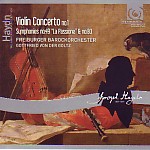That these acid-toned, inexpressive, unidiomatic performances could ever have come to be associated with “authentic” performance practice is a sad statement about how disconnected, pedantic, and tone-deaf some of today’s most technically talented musicians and ensembles have become. Symphony No. 80, one of Haydn’s funniest and most eccentric creations, receives the best performance. Despite the lack of dynamic range and fussy phrasing of the comical “barrel organ” waltz that closes the exposition, the first movement goes well. The adagio, though, is an abomination, with a main theme that cries out for some tonal warmth, some (dare I say it?) vibrato, which certainly was used, and probably extensively, in Haydn’s orchestra. Gottfried von der Goltz & Co’s refusal to produce a natural, singing timbre is all the more puzzling when you consider how cavalier they are with issues of phrasing and dynamics in such odd places as the first big tutti in the finale.
In “La Passione” we find stylistic solecisms of another kind. The opening is marvelously dark and moody, then the harpsichord comes clanking in and completely destroys the atmosphere. It’s a particularly dry-toned instrument too, with a nasty buzz that makes the finale sound like a swarm of locusts on a foraging expedition. This is clearly a case of putting theory before musicality. Can’t these people hear how bad this sounds, or how much damage they are doing to the clear sense of Haydn’s music? As for the Violin Concerto, again, it’s impossible to criticize von der Goltz’s technique as such. He stays remarkably in tune, and his pure tone isn’t entirely unappealing, even in its uppermost register. But it’s hard to imagine that Haydn’s concertmaster, Luigi Tomasini, for whom the concerto was composed, played the rapturous opening of the slow movement so coldly. This is the purity of the grave, and once again the overly prominent harpsichord makes hash out of ensemble balances, homogenizing the dynamics, and generally destroying the music’s built-in scheme of contrasts.
Frankly, all of these musicians need to go back to school and study the human voice, which was the basis for instrumental tone in Haydn’s day, and largely remains so even today. Their first responsibility is to make their instruments sing, and if that means using vibrato, or modern instruments, or whatever else they have to do, then so be it. Haydn deserves no less, and authenticity is not a function merely of applying some stupid theory willy-nilly to the music at hand. True authenticity lies in the audible results, and these are disgraceful.
































